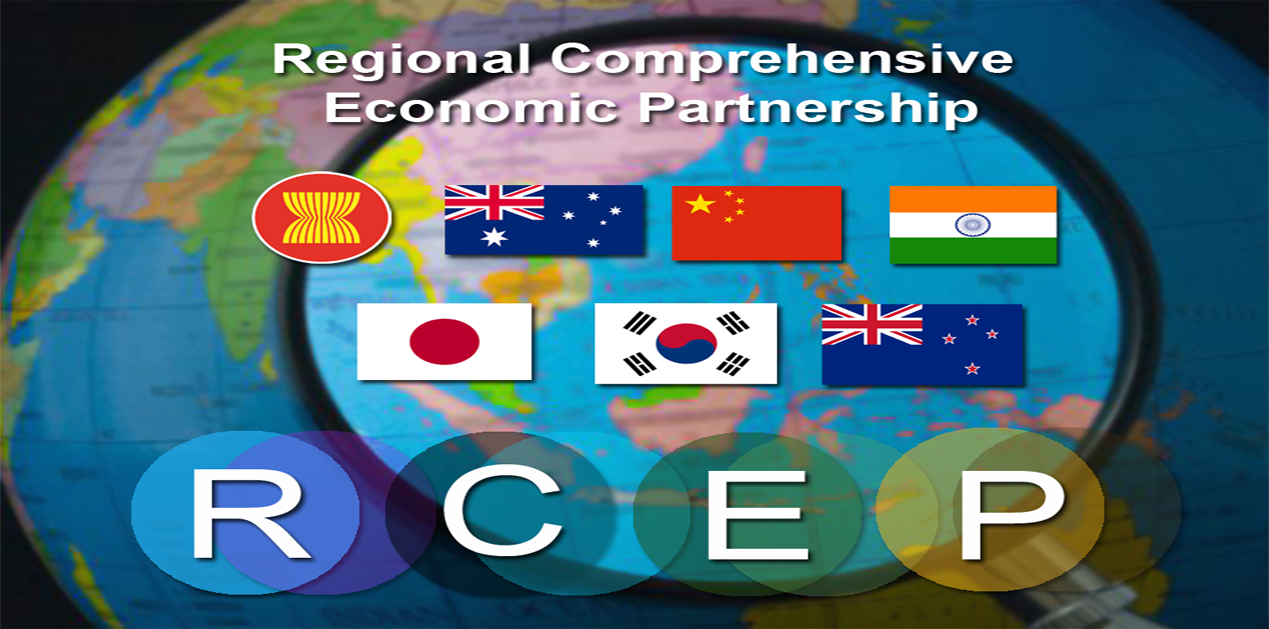The economic world has come a long way since the conception of trade theories like those of ‘Absolute Advantage’ and ‘Comparative Advantage' by Smith and Ricardo. The advent of globalization has led to various forms of economic integration among nations as a direct consequence of these propositions. In 2018, the world markets are increasingly inter-connected and international trade has provided economies with an array of choices at competitive prices for their tradable goods and services1. International trade agreements help facilitate negotiations of terms for the same.
After the liberalization policies of 1992, India has wanted to embrace a multilateral approach to trading. However, delays with the Doha Round negotiations of the World Trade Organization (WTO) have steered India to look at bilateral and regional trade agreements (RTA) 2. The Regional Comprehensive Economic Partnership (RCEP) is one such proposed RTA in which India finds itself as a negotiator.
The RCEP was developed from the Association of South East Asian Nations (ASEAN) + 1 Free Trade Agreements (FTA’s) to enhance economic linkages via trade and investment and contribute to lessen the development gap among the participating countries3. The negotiations began at the 21st ASEAN Summit in Cambodia in 2012 between the 10 heads of ASEAN states and 6 ASEAN FTA partners that include India, China, Japan, Australia, New Zealand and Republic of Korea. If seen through, the RCEP would be the biggest trade agreement after the General Agreement on Tariffs and Trade (GATT) that manifested into the WTO, covering half of the world’s GDP and population, with a coverage of trade in goods and services, investment, economic and technical cooperation, intellectual property, dispute settlement and e-commerce. However, the ASEAN Summit of November 2018, that had sought to reach a conclusion on the RCEP after several rounds of negotiations, concluded with its postponement to 2019. One of the reasons for the delay was mainly attributed to India’s disinclination towards concessions on its tariffs.
Given the current state of negotiations, the RCEP countries want India to effect duty cuts on 92 percent of its tariff lines4. India had initially propagated a three-tier tariff reduction plan, wherein countries coming under the third tier (countries with whom India does not have FTA’s) would be given 42.5 percent of tariff reductions. Even so, in light of gaining something on its service sector, (that comprises of a 3 percent share in global service exports) India withdrew its proposal. Its new proposition of tariff reductions on 74 percent of goods for China and a few other members and 86 percent for the rest of the RCEP participants has not been received positively5. If India were to concede, it would open the Indian Economy to competitor markets, that given its demand needs would only increase its imports. This may in turn hamper domestic markets and the Make in India initiative of the Government, a national production agenda to heighten Indian markets and increase employment creation.
While the aim of trade agreements is to increase international economic activity, the provisions are significantly molded by domestic and international political realities6. The prime point of contention for India when it comes to the RCEP is China. China’s overwhelming presence as part of the RCEP would mean opening up of Indian Markets to a country it runs a $63 billion trade deficit with (half of India’s total trade deficit). Moreover, it is no secret that China enjoys a surplus in manufacturing and dumps its products in various parts of the world, including India7. Reduction of tariffs would provide a means for escalation for China’s dumping activities. Not only will this prove to be a menace to Indian manufacturing industries but also to small and medium entrepreneurs8.
Also, China is a low-cost production center, which flourishes on state subsidized production9. India has thus lost its comparative advantage and tariff and non-tariff barriers in China are not favorable for Indian Exports, thus causing a deficit in trade10. Giving greater market access to China under the RCEP could further skew the trade balance.
Besides China, India also has conflict of interest in giving greater market access to Australia and New Zealand, whose major imports to India include those of agriculture and dairy manufactured products. The present structure of the RCEP would mean the displacement of the local agriculture and dairy manufacturers, some of the most important industries of the Indian Economy11. More so, the market access would also affect the steel industry in India which is most likely to be hit by steel imports from Korea and Japan. Also, apart from China, India has a trade deficit with about seven countries who are a part of the RCEP, including Thailand and Indonesia.
Even though India has made endeavors to connect with the Regional Value Chains (RVC) in the Asian and Oceanian regions, they have not been met with equal enthusiasm from the regional counterparts. The Asia-Pacific Economic Cooperation (APEC) has not yet initiated India into its realm12. APEC might have enabled India for harmonization of tariffs and business standardization, in accordance with its provisions13. This in turn could have established a base for the execution of RCEP trade provisions with the required structural support14.
Nevertheless, the RCEP may have its benefits. Even though there is a trade deficit, is in only tradable goods15. Apart from giving access, India would also gain access to these markets under the RCEP. The RCEP being a comprehensive trade pact, Indian Markets would attain access to further investments, especially those from South Korea and Japan who already have significant investments in India16. India has an added leverage because of its market size17. Its exclusion from the RCEP would mean the other participating countries would lose out on its market potential. Therefore, India must use this to its advantage while negotiating terms. With a view of the comprehensive coverage areas of the RCEP, India can utilize the platform to negotiate not only tariffs where its interests lie for incorporation into the RVC’s, but also for the initiation of regulatory mechanisms for rectifying access-related issues18.
One of the significant positives for India joining the RCEP, according to Sri Rajeev Kher, Former Secretary of Commerce, is that it would provide market opportunities and aid in bringing in discipline on various undesirable aspects of China’s Trade Policy19. Under the RCEP, India can negotiate an agreement on non-tariff barriers, which have earlier prevented growth of Indian exports to China20. Another point of consideration would be India’s participation in the RCEP vis-a-vis the Comprehensive and Progressive Agreement for Trans-Pacific Partnership (CPTPP), a multilateral FTA to reduce tariff and non-tariff barriers between members. The CPTPP was a result of President Trump’s withdrawal from the Trans Pacific Partnership (TPP) and Japan’s continued efforts for it coming into effect as the main policy of the Abe government.
Inflexibilities on Japan’s part with regards to the RCEP maybe attributed to its dedication of the CPTPP that also negotiates tariffs as a significant part of the FTA. Indonesian trade minister Enggartiasto Lukita has gone on to say that Japan and not India has been the problem, with its attempts to enforce its interests on other participants21.
It is interesting to note that CPTPP member states include the RCEP member of Australia, New Zealand, Malaysia, Brunei, Vietnam and Singapore. India is not a part of the CPTPP. After the required ratifications, the CPTPP will come into effect wherein its members that overlap with several from the RCEP will have implemented preferential agreements, possibility at the cost of India22. India would then find its self in a need for a trade agreement like the RCEP that would grant it access to these markets.
With the RCEP deal being postponed to 2019, it has now provided India with some space to think on the lines of its negotiations, especially in light of it going into election year. The key challenge for India would be to effectively negotiate its terms with its domestic interests in mind, that would allow it to the expand its trading activities under the RCEP framework as also bolster its current Act East Policy.
End Notes:
- Goldmansachs.com. (2014). Goldman Sachs 2014 Annual Report: Four Trends Shaping Markets and Economies. [online] Available at: https://www.goldmansachs.com/s/2014annualreport/assets/downloads/GS_AR14_Insight_3_Interconnected_Markets.pdf [Accessed 16 Nov. 2018].
- Ranade, A. (2017). Trade agreements: Theory and reality. [online] https://www.livemint.com/. Available at: https://www.livemint.com/Opinion/ylSO0uM8RM8LnA6FGRjdJM/Trade-agreements-Theory-and-reality.html [Accessed 16 Nov. 2018].
- Asean.org. (2018). Regional Comprehensive Economic Partnership (RCEP). [online] Available at: https://asean.org/?static_post=rcep-regional-comprehensive-economic-partnership [Accessed 16 Nov. 2018].
- DailyHunt. (2018). Delay in Mega Asian Trade Deal Comes as Boon to Modi Govt in Run-Up to 2019 - The Wire English | DailyHunt. [online] Available at: https://m.dailyhunt.in/news/india/english/the+wire+english-epaper-wireng/delay+in+mega+asian+trade+deal+comes+as+boon+to+modi+govt+in+run+up+to+2019-newsid-101427304 [Accessed 18 Nov. 2018].
- Ibid.
- Krist, W. (n.d.). Chapter 3: Trade Agreements and Economic Theory. [online] Wilson Center. Available at: https://www.wilsoncenter.org/chapter-3-trade-agreements-and-economic-theory [Accessed 16 Nov. 2018].
- Mahajan, A. (2018). RCEP is good for regions, but not for India; at least not in present form. [online] Businesstoday.in. Available at: https://www.businesstoday.in/opinion/perspective/rcep-is-good-for-regions-but-not-for-india-at-least-not-in-present-form/story/291375.html [Accessed 17 Nov. 2018].
- Ibid.
- Jha, P. and Yust, M. (2018). Regional Comprehensive Economic Partnership (RCEP) and India. [online] Modern Diplomacy. Available at: https://moderndiplomacy.eu/2018/10/18/regional-comprehensive-economic-partnership-rcep-and-india/ [Accessed 17 Nov. 2018].
- Ibid.
- Gnanasagaran, A. (2018). RCEP delayed to 2019. [online] The ASEAN Post. Available at: https://theaseanpost.com/article/rcep-delayed-2019 [Accessed 17 Nov. 2018].
- Jha, P. and Yust, M. (2018). Regional Comprehensive Economic Partnership (RCEP) and India. [online] Modern Diplomacy. Available at: https://moderndiplomacy.eu/2018/10/18/regional-comprehensive-economic-partnership-rcep-and-india/ [Accessed 17 Nov. 2018].
- Ibid
- Ibid
- The Economic Times. (2017). India has trade deficit with 10 Regional Comprehensive Economic Partnership (RCEP) members. [online] Available at: https://economictimes.indiatimes.com/news/economy/foreign-trade/india-has-trade-deficit-with-10-regional-comprehensive-economic-partnership-rcep-members/articleshow/64620160.cms [Accessed 17 Nov. 2018].
- Ibid.
- Kher, R. (2018). Opinion | The RCEP is a must for India. [online] https://www.livemint.com/. Available at: https://www.livemint.com/Opinion/8d0oL0au6FRutsrgJ4IoPK/Opinion--The-RCEP-is-a-must-for-India.html [Accessed 17 Nov. 2018].
- Ibid.
- Kher, R. (2018). The Why and How of the RCEP. [online] Ris.org.in. Available at: http://ris.org.in/sites/default/files/Policy%20Brief%20_84_RajeevKher-compressed_0.pdf [Accessed 18 Nov. 2018].
- Ibid.
- Iwamoto, K. (2018). India sought to delay RCEP deal beyond general election. [online] Nikkei Asian Review. Available at: https://asia.nikkei.com/Politics/International-Relations/India-sought-to-delay-RCEP-deal-beyond-general-election [Accessed 19 Nov. 2018].
- Kher, R. (2018). Opinion | The RCEP is a must for India. [online] https://www.livemint.com/. Available at: https://www.livemint.com/Opinion/8d0oL0au6FRutsrgJ4IoPK/Opinion--The-RCEP-is-a-must-for-India.html [Accessed 17 Nov. 2018].
Image Source: https://asean.org/wp-content/uploads/2016/10/RCEP-1.png










Post new comment